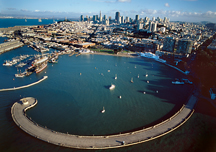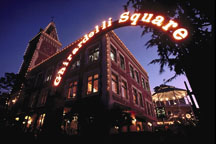Bitter & sweet local history

By Nancy Salcedo
Published: May, 2005
W ithin a three-quarter mile stretch along the San Francisco waterfront, there exist sights not to be missed. The Maritime Museum, Aquatic Park, Ghirardelli Square, and Fisherman’s Wharf all have rich, historical significance and visual appeal that are definitely on the list of must-sees for visitors. Put aside half a day of your trip to venture from Pier 39, where sea lions frolic and play, to Fort Mason, and you’ll consider the time well spent, especially if maritime lore fascinates you.
Aquatic Park is a sheltered Bayshore cove that has been drawing beach-goers since the Gold Rush. Here, you can run (or sit) in the sand, swim (or shiver) in the water that never warms above 60 degrees, and you can anchor your boat in the lagoon for up to 24 hours. The park was developed in the 1930s by the depression-era Works Progress Administration (WPA) and designed in nautical Art Deco style.
Within the park is the National Maritime Museum, where you can check out artifacts salvaged from the ship Apollo, which lies under the corner of Battery and Sacramento Streets, or see a brass scale for weighing gold dust that was uncovered during the excavation for the foundation of the Transamerica Pyramid. Nearby, a map reveals the old sea routes to the gold fields. There are exhibits from California’s whaling days and the oldest-known panoramic photograph taken of the City’s waterfront during the Gold Rush era. You can get a real feel for the masses of masts abandoned offshore, for the historic Barbary Coast Trail and the City’s original shoreline that once extended as far inland as Chinatown.
From the deck of the museum, you can see the Hyde Street Pier and the tall masts of the Balclutha, the sailing vessel launched in 1886 in Scotland. From her home port in San Francisco, the Balclutha sailed around Cape Horn an epic 17 times!
There’s quite a wide spectrum of historic ships with historic significance here, including the Eureka, the railroad ferry built in Tiburon in 1890; and the C.A.Thayer, built in 1895, which carried redwood lumber to San Francisco until 1950. Also, check out the Small Boat Shop where you may catch professional maritime boat builders teaching their craft to their students.
At Fisherman’s Wharf on Pier 45, you can climb aboard the USS Pampanito, a World War II submarine, and the SS Jeremiah O’Brien, a 1943 Liberty ship built in a mere 56 days. During World War II, millions of people migrated to the West Coast to build Liberty ships, the largest class of civilian-made warships ever built. This ushered in the assembly line, and pre-fabricated mass production operations.
Nationwide, 18 shipyards built over 2,700 Liberty ships and one-third of the workforce was women. The Liberty ships ran supplies to US and allied troops, and it has been said that without them, the war could not have been won.
Craving something sweet? Just a short walk from the Maritime Museum is Ghirardelli Square, the historic chocolate factory of Domingo Ghirardelli, who set up the shop in 1852 to supply chocolate to gold miners. You can watch the workers mix chocolate right in front of your eyes. Throughout Ghirardelli Square are restaurants with Bay views, shops, fountain courtyards, and musicians. It’s definitely a worthwhile place to stop and relax after an eventful tour through the historical, naval wonders of San Francisco’s waterfront.


